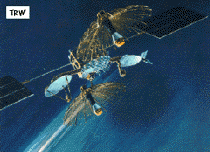TDRSS
Tracking and Data Relay Satellite
Part of the TDRSS program
 When first launched, the TDRS satellites were the largest, most sophisticated communications satellites ever built. The seventh vehicle in the series was ordered as a replacement when TDRS-2 was lost in the Challenger accident.
When first launched, the TDRS satellites were the largest, most sophisticated communications satellites ever built. The seventh vehicle in the series was ordered as a replacement when TDRS-2 was lost in the Challenger accident.
Spacecraft
Hexagonal spacecraft and payload modules. 3-Axis stabilized, zero momentum biased control system uses reaction wheels and Earth sensors. Two solar arrays provide 2 kW BOL (1.7 kW EOL). These arrays have an area of ~ 29 sq. m and are articulated about one axis. Two 40 Ahr NiCd batteries provide power during eclipse. A hydrazine propulsion system with 24 4.45 N thrusters is used for orbit circularization and orbit maintenance. Spacecraft telemetry and commanding performed via a Ku-band communications system, with emergency backup provided by an S-band system.
Payload
Antennas :
Two Single Access (SA) antennas - each antenna is a 4.9 m diameter molybdenum wire mesh antenna that can be used for Ku-band and S-band links. Each antenna is steerable in 2-axes and communicates with one target spacecraft at a time.
One Multiple Access (MA) S-band antenna array - an electronically steerable phased array consisting of 30 fixed helix antennas. The MA array can receive data from up to 20 user satellites simultaneously, although it can transmit to only one satellite at a time. Twelve of the helices can transmit and receive, with the remainder only able to receive.
One Space to Ground Link antenna (SGL) - a 2 meter parabolic antenna operating at Ku-band that provides the communications link between the satellite and the ground. All customer data is sent through this dish, as are all regular TDRS command and telemetry signals. The antenna is gimballed on two axes.
One S-band omni antenna - a conical log spiral antenna used during the satellite's deployment phase and as a backup the event of a spacecraft emergency. This antenna does not support customer links.
One small Ku-band and one small C-band antenna are also carried, designed to support communications with Westar satellites, but are no longer used.
Transponders Four (plus 2 spare) 25W Ku-band TWTAs for LP (linearly polarized) zone coverage
Two (plus 2 spare) 1.5W Ku-band TWTAs for CP (circularly polarized) spot coverage
Two (plus 4 spare) 25W Ku-band TWTAs for LP zone coverage
Two (plus 2 spare) 1.5W Ku-band TWTAs for CP spot coverage
12 5W TWTAs for LP C-Band up/down
Two (plus 2 spare) 26W S-band SSPAs (used for intersatellite links)
Eight (plus 4 spare) 3.5W S-band SSPAs (used for intersatellite links)
| Country of Origin | United States |
| Customer/User | Contel for NASA, GSFC |
| Manufacturer(s) | TRW |
| Size | 3 m diam bus, 17.4 m span across deployed solar arrays |
| Orbit | All geosynchronous : TDRS 1: 49 deg. W/ TDRS 3: 275 deg. W/ TDRS 4: 41 deg. W/ TDRS 5: 174 deg. W/ TDRS 6: 47 deg. W/ TDRS 7: 171 deg. W |
| Design Life | 10 years |
| Related Sites | TDRSS Home Page |
Launch Facts
| Name | Int'l Desig. | Date | Site | Vehicle | Orbit | Mass(kg) |
| Notes | ||||||
| TDRSS 1 | 1983-026B | 4/4/83 | ESMC | STS 6 | GEO | 2268 |
| Element of satellite communications network, deployed from STS-6 4/5/83 | ||||||
| TDRSS 2 | none | 1/28/86 | ESMC | Shuttle | FTO | |
| Destroyed in Challenger explosion | ||||||
| TDRSS 3 | 1988-091B | 9/29/88 | ESMC | STS 26 | GEO | 2200 |
| NASA communications; 171 deg W; deployed from STS-26 | ||||||
| TDRSS 4 | 1989-021B | 3/13/89 | ESMC | STS 29 | GEO | 2120 |
| Deployed from STS 29 3/13/89; NASA communications; 41 deg W | ||||||
| TDRSS 5 | 1991-054B | 8/2/91 | ESMC | STS 43 | GEO | 2200 |
| NASA communications; 174 deg W; deployed from STS-43 8/2/91 | ||||||
| TDRSS 6 | 1993-003B | 1/13/93 | ESMC | STS 54 | GEO | 2530 |
| NASA communications; deployed from STS-54 1/13/93 | ||||||
| TDRSS 7 | 1995-035B | 7/13/95 | ESMC | STS 70 | GEO | 2120 |
| NASA communications; deployed from STS-70 on 7/13/95; 171 deg W | ||||||
Information in The Mission and Spacecraft Library is provided without warranty or guarantee. USE AT YOUR OWN RISK.